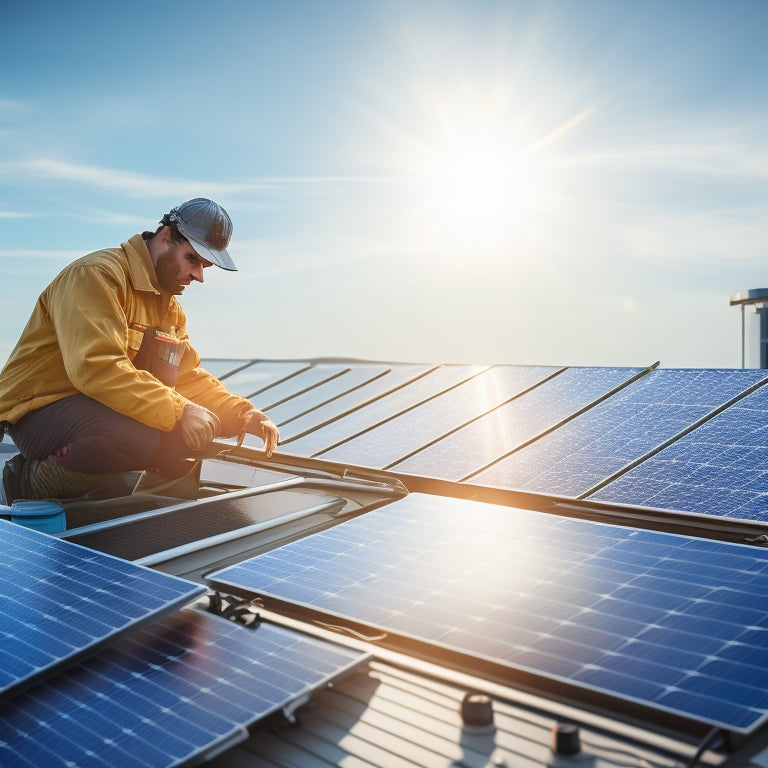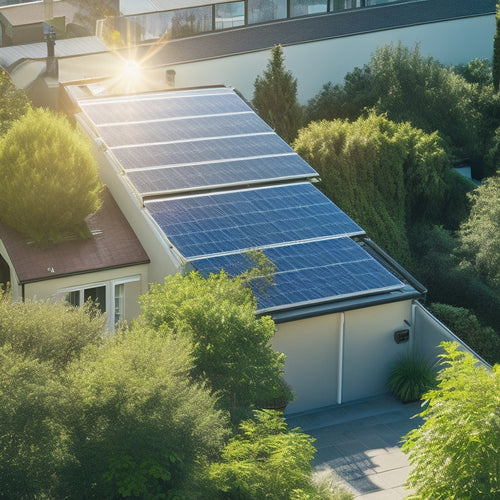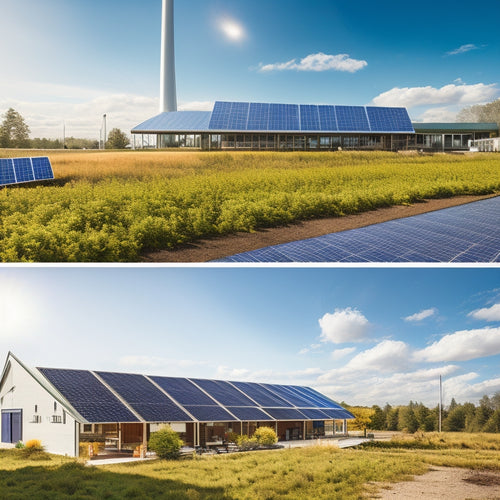
Business Solar Power Maintenance Strategies
Share
To maintain your business's solar power systems effectively, focus on regular performance monitoring and timely inspections of critical components. Track energy output for deviations and conduct biannual checks for wear or corrosion. Implement energy audits to assess usage patterns and adjust your solar setup accordingly. This proactive approach not only prevents costly failures but also guarantees that your systems operate at peak efficiency, potentially increasing energy production by up to 20%. By aligning maintenance strategies with your specific energy needs, you can optimize returns and sustainability. Investigate further to uncover additional strategies for maximizing your solar investment.
What You Need to Know
- Regular performance monitoring and timely inspections maximize energy output and prevent costly system failures.
- Conduct energy audits to understand consumption patterns and optimize solar array size accordingly.
- Utilize federal incentives and tax benefits to reduce initial solar installation costs and enhance ROI.
- Implement preventive maintenance strategies to ensure peak efficiency and extend the lifespan of solar components.
- Engage employees in sustainability initiatives to foster responsibility and enhance overall environmental impact.
Cost-Effective Energy Solution
When you assess solar power, consider its long-term savings potential, which can greatly reduce your operational costs.
Moreover, innovations in space-saving designs for solar installations can additionally optimize your setup and efficiency.
Likewise, various incentives and tax benefits can enhance your financial returns, making solar an even more appealing option.
Understanding these factors will help you maximize the cost-effectiveness of your investment in solar energy.
Long-Term Savings Potential
Businesses that invest in solar power systems can realize significant long-term savings, often recouping their initial investment within five to seven years. This quick payback period is a result of decreasing energy costs and rising electricity rates, making solar a financially sound choice.
In addition, with the potential energy cost savings of up to 50% on monthly electricity bills, financial aspects of solar investment should be carefully evaluated. When you analyze your solar investment, it's crucial to conduct thorough financial forecasting to project future savings accurately.
By reducing or even eliminating your monthly electricity bills, you can allocate those funds toward other operational needs, enhancing overall cash flow.
Also, solar systems typically have a lifespan of 25 years or more, providing decades of clean energy at a fraction of traditional utility costs.
You'll also benefit from increased property value, as potential buyers often see solar installations as a desirable asset.
Additionally, as energy independence becomes more critical, having a reliable solar system can shield your business from market fluctuations and unpredictable utility pricing.
Incentives and Tax Benefits
Incentives and tax benefits play an important role in making solar power an attractive investment for businesses. By leveraging federal incentives and state rebates, you can greatly reduce upfront costs associated with solar installations. Remarkably, programs such as federal tax credits can provide substantial savings on installation expenses.
Tax credits, such as the Investment Tax Credit (ITC), allow you to deduct a considerable percentage of your solar expenses from your federal taxes, enhancing your return on investment.
Additionally, investment deductions enable ongoing financial benefits, further solidifying solar energy as a cost-effective solution. Exploring solar financing options can also provide you with low-interest loans or leasing arrangements, minimizing financial strain while maximizing renewable energy adoption.
Moreover, numerous grant opportunities and local programs can supplement your solar project, providing further financial assistance. Staying informed about changing energy policies is vital, as these can influence available incentives.
Environmental Impact Reduction
To effectively reduce environmental impact, you should implement emission reduction techniques alongside sustainable energy practices.
By optimizing your solar power systems, you can enhance energy efficiency while minimizing greenhouse gas emissions.
Utilizing optimized storage layout can streamline your operations and contribute to sustainability efforts.
Evaluating your current maintenance strategies will help you identify areas for improvement in both performance and sustainability.
Emission Reduction Techniques
Reducing emissions is critical for enhancing environmental sustainability, and implementing effective techniques can considerably minimize a business's carbon footprint. One of the most impactful methods involves adopting carbon offsetting strategies. By investing in projects that capture or reduce greenhouse gases, you can counterbalance your emissions and contribute to a greener planet. It's vital to choose credible projects and confirm they align with your organization's values.
Moreover, the integration of solar energy can greatly reduce reliance on fossil fuels, thereby amplifying your emission reduction efforts and enhancing brand reputation as a responsible business entity through environmental responsibility.
Additionally, obtaining renewable energy certifications can greatly enhance your credibility and demonstrate your commitment to sustainability. These certifications validate your use of renewable energy sources, like solar power, thereby encouraging additional investment in clean technologies. You should also consider integrating energy management systems to monitor and optimize your energy consumption, identifying areas for improvement.
Engaging employees in sustainability initiatives cultivates a culture of responsibility and accountability, enabling them to contribute to emission reduction goals. Regularly reviewing your operational practices helps uncover inefficiencies that could be optimized for lower emissions.
Sustainable Energy Practices
Sustainable energy practices play an essential role in minimizing environmental impact while maximizing operational efficiency. By adopting renewable energy sources, like solar power, you enhance energy independence and reduce reliance on fossil fuels.
Prioritizing energy efficiency through advanced green technology not only cuts costs but also contributes to a cleaner environment. Implementing solar innovations, such as efficient photovoltaic systems, allows you to utilize clean energy effectively.
Combining these systems with strong resource management strategies guarantees peak performance, reducing waste and enhancing energy conservation. You can adopt sustainability practices that integrate eco-friendly solutions into your daily operations, promoting a culture of environmental responsibility.
Additionally, consider regular assessments of your energy consumption patterns. This analytical approach enables you to identify areas for improvement, thereby maximizing energy efficiency.
System Performance and Reliability
To guarantee optimal system performance and reliability, you need to implement regular performance monitoring of your solar power setup. This involves tracking energy output and identifying deviations from expected performance metrics.
Additionally, timely component inspections will help you detect wear and tear, preventing costly failures and downtime.
Regular Performance Monitoring
Regular performance monitoring is essential for ensuring the reliability and efficiency of your solar power system. By utilizing advanced monitoring tools, you can track energy production, system performance, and potential issues in real-time. This proactive approach allows you to identify any deviations from expected output, ensuring that your investment remains profitable.
Performance analytics play a key role in this monitoring process. By analyzing data trends over time, you can discern patterns that may signal underperformance or equipment malfunction. For instance, if your solar panels consistently produce less energy than anticipated, you can investigate potential causes, such as shading, dirt accumulation, or component failures.
Moreover, consistent performance monitoring helps you maintain warranty requirements and optimize your system's lifespan. By keeping records of your system's output and any anomalies, you can provide significant observations to your service provider, allowing for informed decision-making.
Ultimately, regular performance monitoring enables you to take charge of your solar investment, ensuring that you utilize the maximum potential of renewable energy. Embracing this strategy not only enhances system reliability but also aligns your operations with the freedom and sustainability that solar power offers.
Timely Component Inspections
While monitoring your solar system's performance is essential, timely component inspections are equally important for maintaining its efficiency and reliability.
Regular inspections help you identify potential issues before they escalate, ensuring the longevity of your investment. By incorporating preventive maintenance into your routine, you can effectively reduce downtime and maximize energy output.
You should schedule inspections at least biannually, focusing on critical components like inverters, solar panels, and electrical connections. Look for signs of wear, corrosion, or damage, as these can greatly impact performance.
For instance, a malfunctioning inverter can lead to reduced energy conversion, costing you money in the long run.
Don't overlook the importance of component upgrades during these inspections. Technology evolves rapidly, and upgrading to more efficient panels or inverters can enhance your system's overall performance.
Selecting Based on Energy Needs
To optimize your solar power system, you need to assess your energy consumption patterns thoroughly.
Understanding these patterns allows you to evaluate your system's efficiency needs accurately.
This analysis guarantees that your solar setup meets your specific energy demands effectively.
Assessing Energy Consumption Patterns
Evaluating energy consumption patterns is essential for optimizing the performance of your solar power system. By conducting thorough energy audits, you can identify peak usage times and specific energy demands. This consumption analysis allows you to tailor your system to meet your unique needs, guaranteeing that you utilize the maximum potential of your solar panels.
Start by monitoring your energy usage over different periods, such as weekdays versus weekends or seasonal variations. This data will help you comprehend when your energy demands are highest and enable you to adjust your solar setup accordingly. For instance, if you notice high consumption during daylight hours, you'll want to ascertain your solar array is adequately sized to meet that demand.
Additionally, integrating smart energy management systems can provide real-time observations into your usage patterns, allowing for more precise adjustments. This proactive approach not only improves your system's efficiency but also contributes to significant cost savings over time.
Evaluating System Efficiency Needs
When considering your solar power system's efficiency, it is crucial to align your setup with your specific energy needs. Evaluating performance benchmarks will help you identify areas for improvement. You should regularly assess your system's output against your energy consumption patterns. This will enable you to determine if system upgrades are necessary to optimize efficiency.
Here's a quick reference to help you evaluate your solar power system's efficiency needs:
| Criteria | Considerations |
|---|---|
| Current Energy Usage | Analyze monthly consumption |
| System Output | Compare with expected output |
| Performance Benchmarks | Check industry standards |
| System Upgrades | Evaluate potential enhancements |
| Return on Investment (ROI) | Assess long-term savings |
Long-Term Savings Potential
By implementing solar power, you can greatly reduce your energy costs over time.
This reduction directly correlates with the efficiency of your maintenance strategies and the longevity of your solar system.
Understanding the financial implications of these savings is essential for maximizing your investment.
Reduced Energy Costs
Notable reductions in energy expenses can be achieved through effective solar power maintenance strategies, providing businesses with considerable long-term savings. By focusing on solar panel longevity, you guarantee that your system operates at peak efficiency, ultimately countering the rising energy price trends. Proper maintenance not only extends the lifespan of your solar panels but also enhances energy production, which directly translates to reduced utility bills.
| Maintenance Strategy | Potential Savings |
|---|---|
| Regular Cleaning | Up to 20% energy increase |
| Inverter Checks | Avoids 15% efficiency decline |
| System Inspections | Identifies issues early |
Implementing these maintenance tactics can lead to significant energy cost reductions over time. As you observe energy price trends, maintaining your solar system becomes vital to maximizing savings. By verifying that your solar panels are well-maintained, you not only protect your investment but also enable your business with greater financial freedom. In a world where energy costs fluctuate, taking control of your solar power system is essential for long-term success.
Frequently Asked Questions
How Often Should Solar Panels Be Cleaned for Optimal Performance?
To optimize your solar panels' performance, aim for a cleaning frequency of every six months. Dirt and debris can greatly impact efficiency, so regular maintenance guarantees you maximize energy output and enjoy your energy independence.
What Tools Are Needed for Basic Solar Panel Maintenance?
For effective solar panel cleaning, you'll need maintenance tools like a soft-bristle brush, hose, squeegee, and non-abrasive cleaner. These tools help you safely remove debris and maintain peak performance for your solar energy system.
Are There Specific Safety Precautions for Solar Power Maintenance?
Before you climb up, make certain you're wearing your safety gear. Remember, electrical hazards lurk in every panel. Keep your tools insulated and stay aware; one misstep could lead to serious consequences. Safety first, always!
How Do I Identify Signs of Solar Panel Damage?
To identify signs of solar panel damage, check for cracks, discoloration, or loose connections. Monitoring performance can reveal common issues affecting solar panel lifespan and help you ascertain peak energy production and longevity.
Can I Perform Maintenance Myself or Hire a Professional?
You can choose DIY maintenance for hands-on control or hire professional services for expert care. Weigh the benefits of your skills against potential risks to guarantee your solar system operates efficiently and safely.
Explore More
In summary, implementing effective solar power maintenance strategies not only maximizes system performance but also greatly improves your long-term savings. It's a common belief that solar systems are low-maintenance; however, regular upkeep is vital for ideal energy output. By selecting the right maintenance practices customized to your specific energy needs, you can guarantee reliability and sustainability. Ultimately, you're not just investing in a cost-effective energy solution—you're actively participating in a greener future while safeguarding your investment.
Related Posts
-

How Solar Panels Reduce Electricity Bills
Solar panels can drastically cut your electricity bills by utilizing sunlight to generate your own energy. This decre...
-

Energy-Efficient Lighting Solutions for Sustainable Buildings
For sustainable buildings, energy-efficient lighting solutions, like LEDs, offer multiple benefits. These bulbs last ...
-

Off-Grid Solar Solutions for Eco-Conscious Businesses
Off-grid solar solutions offer you a path to both sustainability and substantial cost savings. By adopting these syst...


